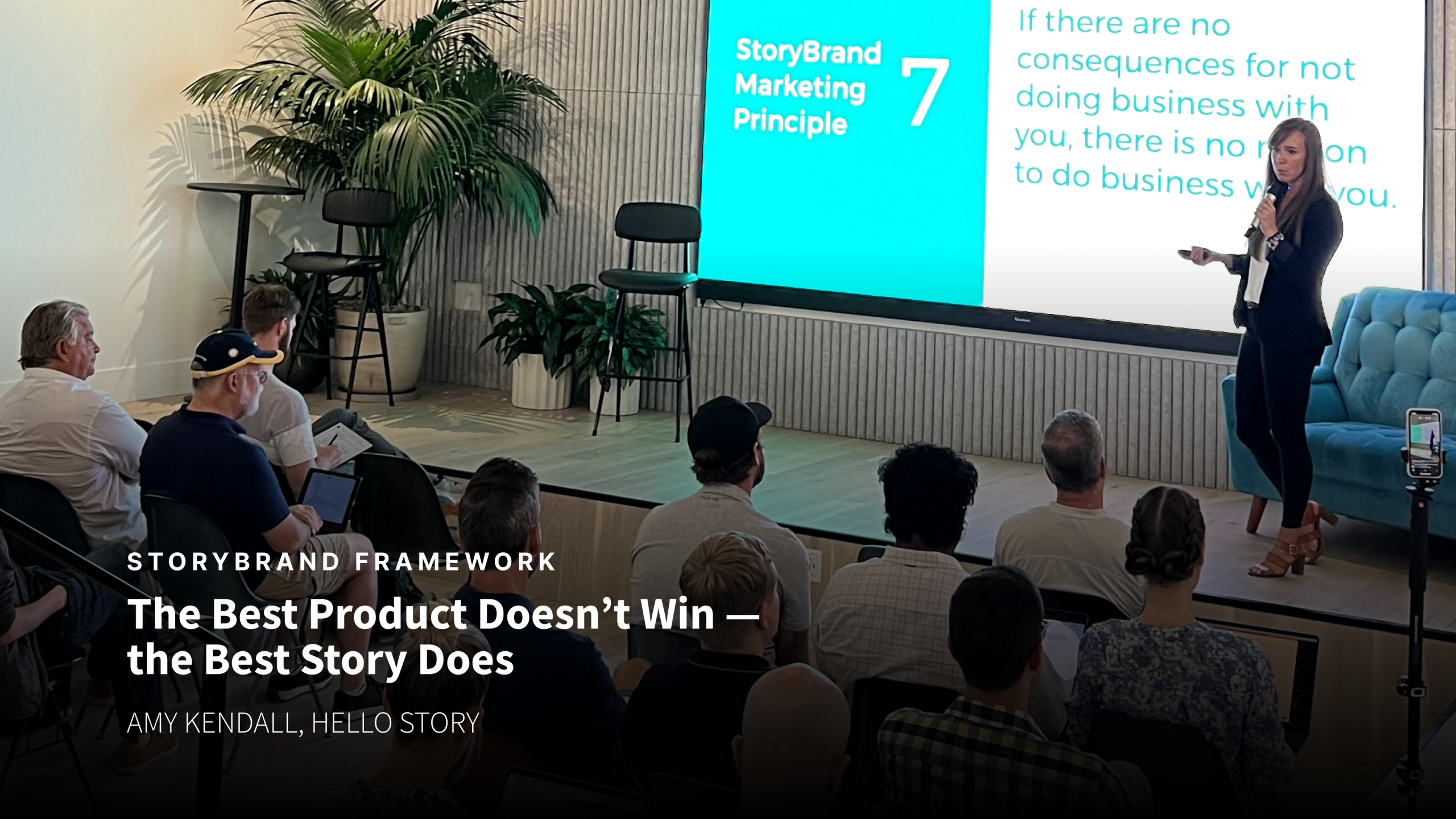
How to Make Your Customer the Hero of Your Marketing Story
You’ve poured your heart and soul into creating an amazing product. Only to watch competitors with lesser offerings take the lead. Why? Their messaging resonates, while yours falls flat. In today’s market, the best product doesn’t win—the best story does.
Amy Kendall, certified StoryBrand guide and founder of Hello Story, recently taught, “Competitors with inferior products will come out on top if their messaging is better.”
If you want to see real traction, you’ve got to nail your messaging. The StoryBrand framework teaches that the most effective brand messages are those that tell a clear story.
And here’s the hard truth: your brand is NOT the hero of the story. The customer is.
So where do you fit into the story? Your brand is their wise guide—the Yoda to their Luke Skywalker, the Haymitch to their Katniss. It’s time to straighten out the facts and put your customer as the focus.
Here’s how to get your messaging right and stop wasting money on marketing that doesn’t work.
Brains Are Wired to Survive and Thrive
Before diving into actionable tips, let’s touch on a fundamental truth: Our brains are wired to survive and thrive while conserving energy. Your customer’s brain is scanning your website, email, or social feed with one subconscious question: “Can this help me survive or thrive?”
If your marketing message isn’t clear—if it’s filled with jargon, fluff, and unclear calls to action—you’re asking their brain to work too hard. And if it has to work too hard, it will quickly move on.
“Without a clear message, customers get confused—and if you confuse, you lose,”
So, let’s cut through the clutter and get clear: storytelling is the powerful tool that makes it all possible.
The Power of Story: Your Customer is the Hero, You’re the Guide
According to the StoryBrand framework, a story works because it organizes information in a way that helps the brain survive and thrive. It’s compelling. It’s simple. And it gets customers to pay attention.
“A good story is what captivates your audience, builds trust, and ultimately drives action,”
Remember, the key to making your marketing story successful: your customer is the hero. You are the guide.
This is where most brands fail.
We get it. We all want to be the hero, the savior of the story.
But your customer doesn’t need another hero. They want someone who can help them win the day, solve their problem, and lead them to success.
How to Apply the StoryBrand Framework to Your Brand:
1. Define What Your Hero (Customer) Wants
Your customer needs to know what they can achieve by working with you. Your message should be broad enough to reflect your overall brand but specific enough to spark interest. Focus on a clear desire that speaks to their needs. What do they really want?
For example, the headline of your website could say, “New glasses frames,” or “Confidence in healthy eyes and good vision”.
Which one positions the customer as the hero of the story?
The latter.
Take Action: Write down in one sentence what your customer wants from you. Can you sum it up in less than 10 words? If not, keep simplifying.
2. Identify the Problem
“The problem is the heart of the story.”
What’s the obstacle the hero (customer) is facing that keeps them from getting what they want?
Bonus tip: The problem has layers—external (the tangible issue), internal (the emotions they’re feeling), and philosophical (the higher purpose).
Take Action: Ask yourself what’s bothering your customer. Is it wasted time? Lack of clarity? Inefficient processes? Get clear on their problem. If you don’t know the answer, go talk with your customers! Face to face feedback is better than taking a guess.
3. You Are the Guide
Remember, your job is to support the hero; your brand is the hero’s (customer’s) guide. You are the character that moves the story forward and leads the hero toward the solution. Just like Mary Poppins stepping in to save the Banks family, you provide the roadmap to success.
To be an effective guide, you need two things:
- Empathy (“I get where you’re coming from.”)
- Authority (“I know how to solve this.”)
Take Action: Make sure your messaging reflects empathy and competence. Share success stories, case studies, or testimonials that show you’ve been there, done that, and nailed it.
4. Give Them a Plan
Here’s where you lower the stakes by giving your hero a simple roadmap to success. You’re making it easy for them to take the next step and experience what you have to offer. Not only do you tell them how to work with you, but also how working with you will make their life better.
Take Action Create 3-4 simple steps they can follow to work with you.
Example:
- Schedule a demo
- Download our software
- Set up your metrics
- Start seeing results in 7 days.
5. Call to Action
If you want your customers to take action, you have to ask. Don’t be shy. Don’t be vague. “Get started” doesn’t cut it. You need clear, powerful calls to action like:
- Buy Now
- Schedule a Call
- Watch the Demo
If your website is filled with wishy-washy buttons, your customers won’t know what to do next. And if they don’t know what to do, they won’t do anything.
Take Action: Look at your marketing material. Do you have a clear, direct call to action? If it says “Get Started,” change it to something more specific.
6. Success and Failure
Every good story has stakes:
- What happens if the hero wins?
- What happens if the hero fails?
“People are motivated to move towards success and avoid failure.”
Don’t be afraid to paint a picture of both. What does success look like for your customer? What happens if they don’t solve their problem?
Take Action: In your marketing, describe both outcomes. Use words and imagery to show the future your customer could have with you (confidence, success, savings), and the consequences of inaction (wasted time, frustration, lost revenue).
Your Next Step: Clarify, Clarify, Clarify
“The key to a good story is clarity.”
If you confuse, you lose. Trim your message down to the essentials—if it doesn’t fit into the story, leave it out.
Take Action: Go through your website and cut out anything that doesn’t help the customer survive and thrive. Keep your messaging clear, concise, and to the point.
Ready to be the guide your customers are looking for? Follow the StoryBrand marketing framework. Get started with a free resource here.




No comment yet, add your voice below!